When one of Japan’s biggest tackle brands took off the gloves and designed their lightest ever reel - including a completely new braking system – the Shimano Aldebaran BFS 2016 “XG” was born (scroll down for short on-stream video)
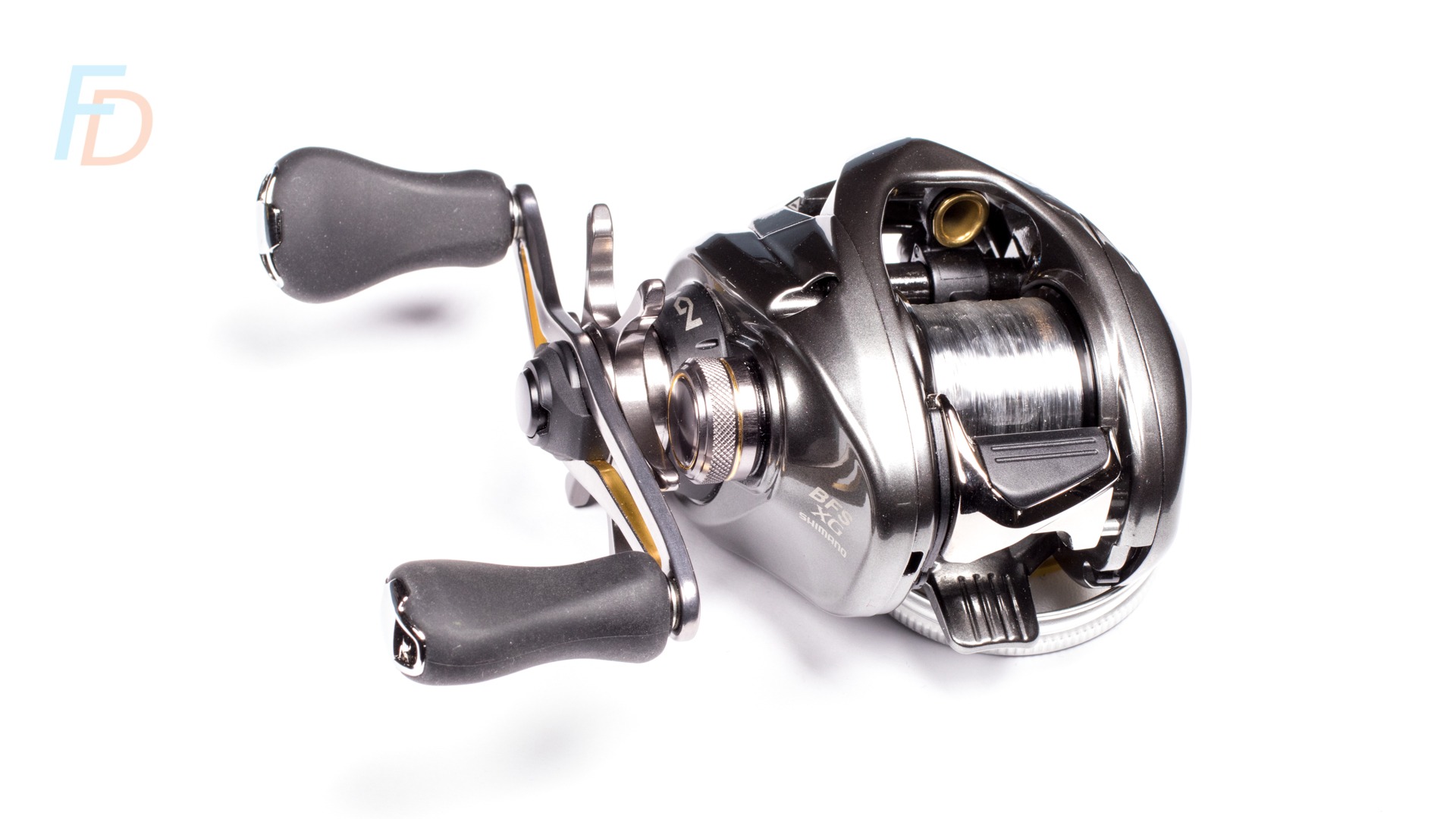
As with other gear reviews, you can click to skip straight to the raw numbers. However, the chances are you’ll also want to find out a bit more about the experience of fishing with the Aldebaran. After all, it usually pays to have a good feel for the significant milestones in gear development and refinement. The 2016 Aldebaran can certainly claim to be just that when it comes to BFS (Bait Finesse System) fishing.
Here's a 2 minute Vlog entry showing the 16 Aldebaran BFS in action catching wild trout on a small stream:
What Makes a Great BFS Reel (...and how does the Aldebaran measure up?)
When it comes to casting light and ultralight lures on a baitcasting reel – there will always be three major factors that a reel simply has to get right.
The first and second factors (Spool-weight and bearings quality) act as a pair – since they need to minimise the inertia of the spool beginning to rotate.
Thirdly, a BFS reel needs brakes that can handle the fast start-up rpm of the spool coupled with the lower momentum of a light lure flying out.
Light, air-resistant lures are less able to take up and tow out line coming off the spool – since their momentum is lower and the distance they’ll fly is shorter.

On that last point I dive a bit more into what can go wrong in that process – particularly with light lures – in the BFS casting article here.
So what did the Shimano Aldebaran BFS 2016 bring to the table in a bid to change the game?
Core Features of the Factory Version Shimano Aldebaran BFS 2016 XG
What about the name?
While I don't know exactly what the Shimano product designers had in mind when they named the Aldebaran you might find it interesting to know that the name Aldebaran refers to a few things including:
The brightest star in the constellation of Taurus
An airborne micro-launcher rocket system
When it comes to the alphabet soup of letters featured after baitcasting reel names “XG” usually stands for “eXtreme” Gear ratios. In practical terms this usually means ratios of 8:1 or more. In the Aldebaran's case, the XG model gear ratio is exactly 8:1. For such a little reel; it’s pretty impressive that the Shimano Aldebaran BFS 2016 XG recovers 80cm of line per handle-turn.
Shimano also make the Aldebaran BFS available in a 6.5:1 gear ratio - which drops the "XG" label. Instead of replacing that with "HG" (for "high gear") - the slower gear model is usually listed as follows:
Shimano 16 Aldebaran BFS 6.5
In this model, 65cm of line are recovered per handle-turn.
By showing both model labels, you know what to look out for when choosing your preferred gear ratio (and don't waste time searching for a "HG" model!
As you can see from the very first picture (top of this page) the Aldebaran features a cone-shaped line-guide. This acts to reduce the angle and friction between the surfaces of that line guide and the line peeling off the spool during casting.
To complete the package, there’s a 7.2 g magnesium spool and a “Hagane” concept magnesium body for a total of just 130g (4.6 oz).

Of course, there’s also those funky magnetic – yet spring-loaded/variable FTB brakes that adjust the braking force during the cast.
At the core of it all, you should also expect the typical well-engineered feel of the gearing and drive system when turning the crank. The low-profile styling of this reel has now become very familiar, particularly with other reels modelling this look for themselves (especially the Fishband GH100).
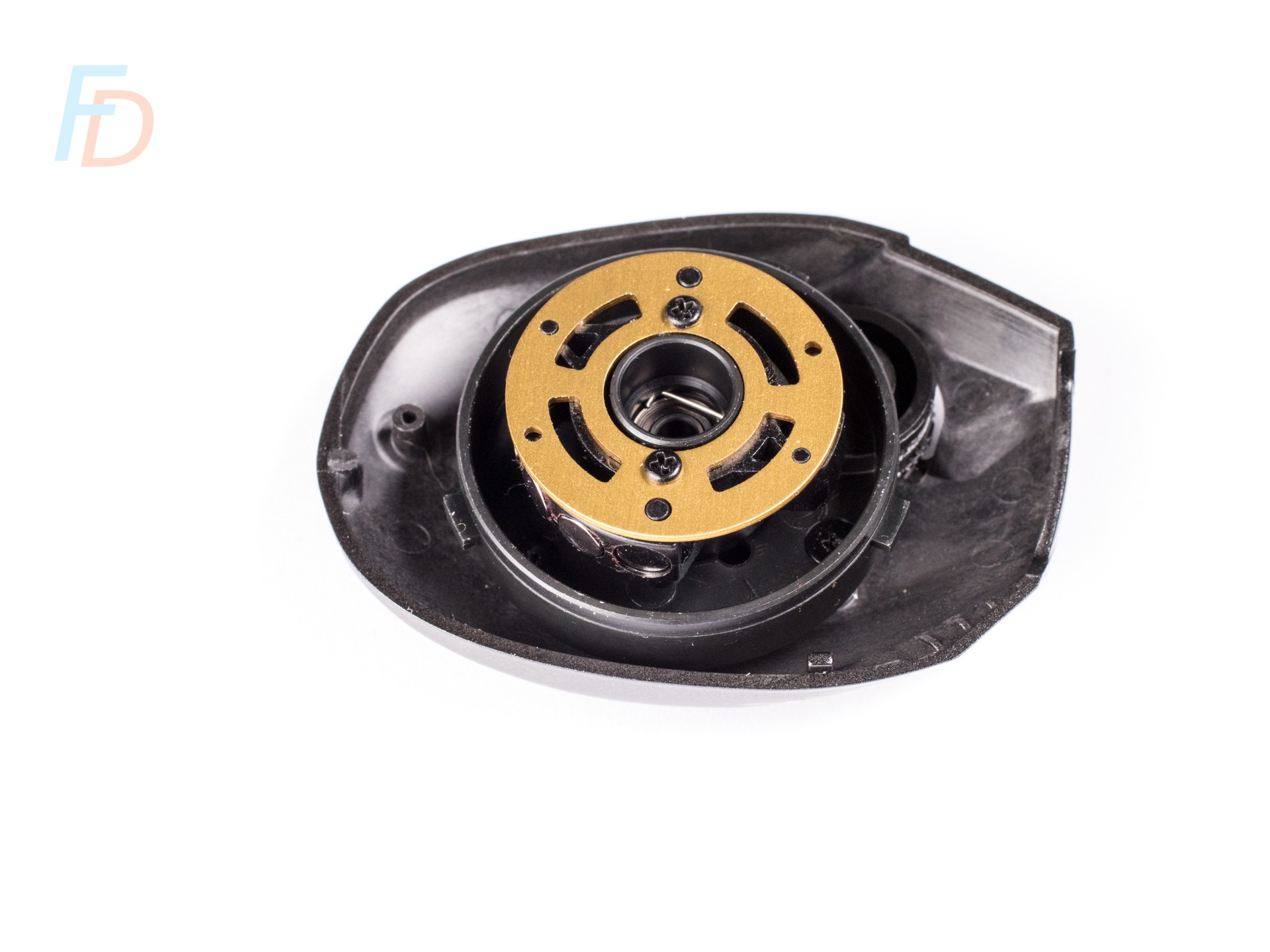
Dynamic magnetic casting brakes in the FTB system (note the small disk-shaped magnets are recessed almost flush for the factory spool)
In common with the 2017 Calcutta Conquest BFS HG – the oversized gears paired with the X-Ship System create a very robust drive system. Strangely, though, when you pick it up out of the box and just turn the crank (with no line/lure attached); there is a slight “growl” to the gears.
Even stranger, that growl seems to disappear when you actually attach a lure and wind it back through the water. There seems to be something about subjecting the drive system to a slight load that beds everything in.
Significant After Market Mods Available?
It’s tough to mention the Shimano Aldebaran BFS 2016 without, in the next breath, referencing after-market spools like the Avail microcast ultralight spools. Take care since these come in different spool depths/line capacities and vary (fractionally) between 4.9 and 5.1g in weight.
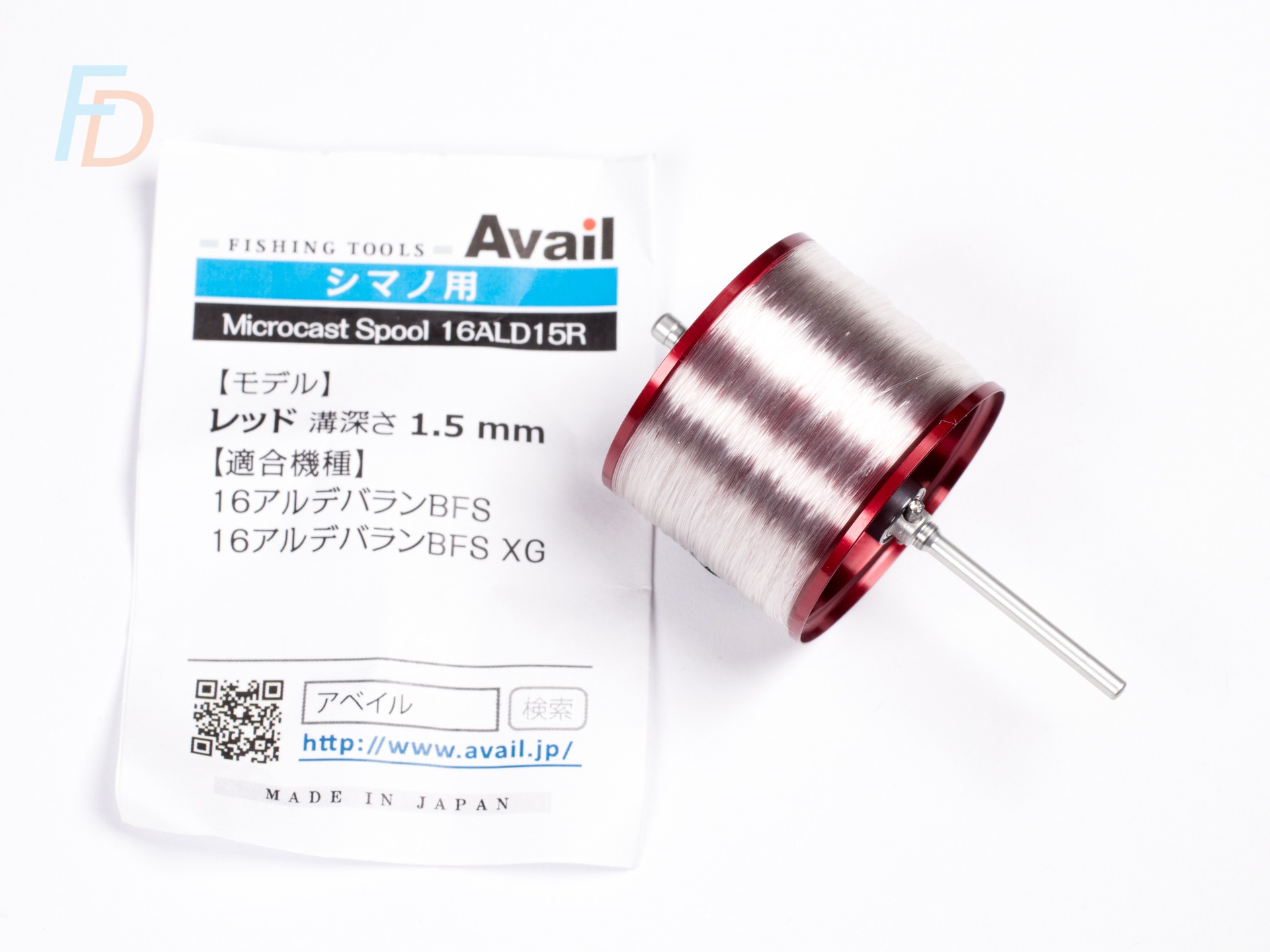
However, with one of those fitted (perhaps even adding dedicated ultra high-speed/micro bearings to further minimise start-up inertia); you enter the realm of seriously light lure casting ability.
Another important point to note is that you'll probably also want to add extra magnets to the FTB braking system if you opt for the Avail spool. WARNING: if you do this - be sure to remove those magnets again if you swap back to the original spool (since there's a good chance that they'll rub up against the inside of the factory spool).

Avail spool (right), four extra magnets (bottom) PLUS extra magnets fitted to the FTB system (standing proud of the recesses on the brake perimeter; left)
Fishing Reports with the Shimano Aldebaran BFS 2016 XG
Features are all well and good – but what is the actual experience like when fishing the Shimano Aldebaran BFS 2016 XG on stream? I’ll split this up into “factory spool” and “Avail microcast spool” sections.
Aldebaran BFS: Factory Spool
Here's a view of the factory spool while fitted into the reel (showing the fit/tolerance between spool and reel-body):

Pairing it with a favourite 5ft glass rod (rated for 1 to 5g lures), the Aldebaran is a ton of fun straight out of the box. One of my favourite baits to throw is a 1.65g Zoner minnow (fitted with one, barbless single hook). This suspension jerk bait doesn’t have a weight transfer system in the 50-mm model – so it is pretty light and also fairly un-streamlined in flight. That can be a challenge for baitcasting reels; and the Aldebaran handles it well, even without the ultralight spool.
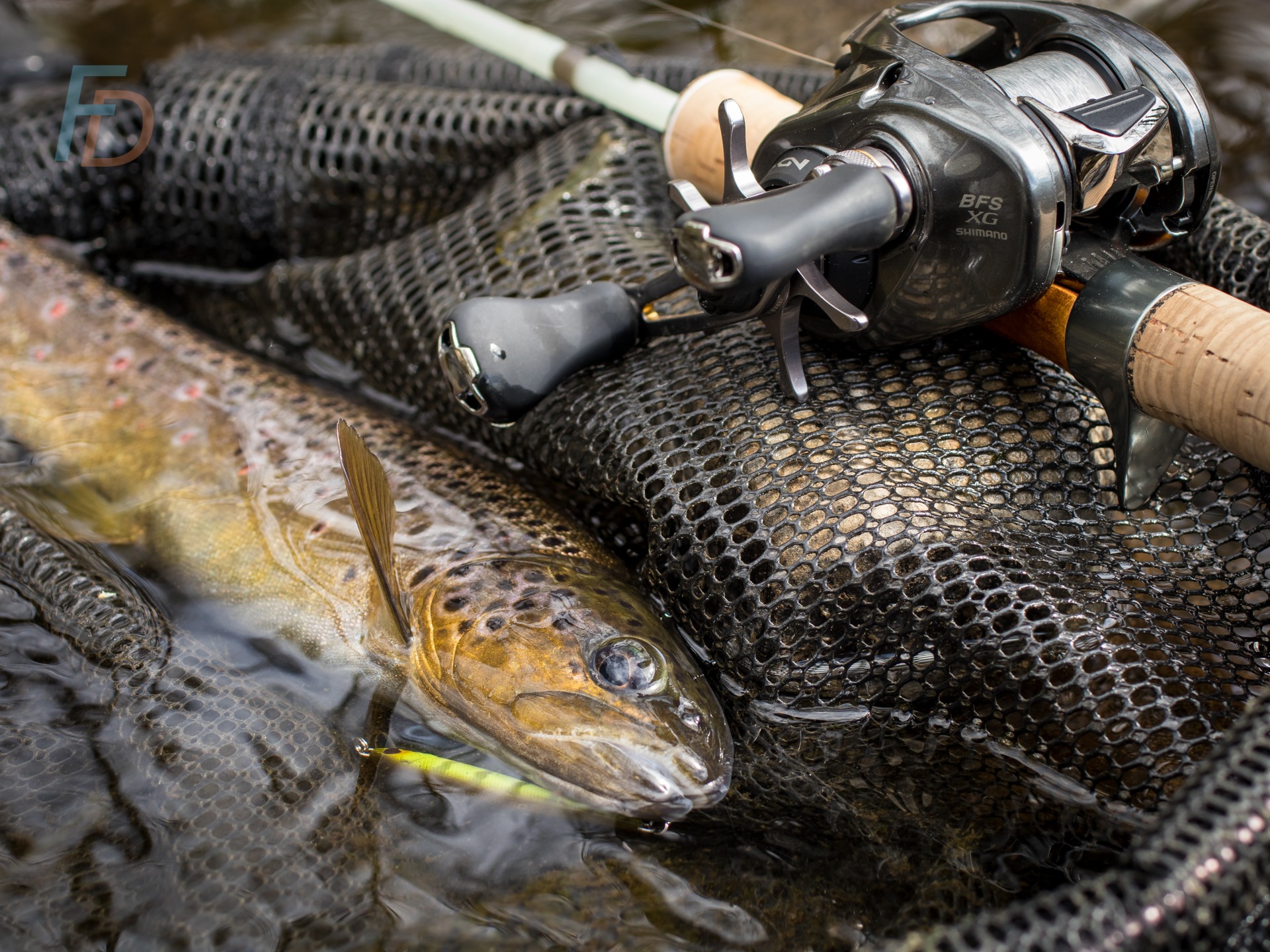
1.65g Zoner Minnow (one barbless single hook fitted) cast on the factory-fitted, black, Aldebaran spool
The smooth drag with an audible clicker when line is paid out (fitted as standard; which is an advantage the Aldebaran has over Daiwa’s Alphas Air TW 20 and their Alphas Air Stream Custom) is great for taming fish. Clicking drag star adjustments feel high-quality and positive. Spool-tension is adjusted by a silent (non-clicking) dial.
Avail Microcast Spool on the Shimano Aldebaran BFS 2016
In my side-by-side fishing comparisons with the Daiwa Alphas Air Stream Custom – I was surprised that the ASC actually cast slightly more accurately and smoothly with that same Zoner Minnow bait. This was perhaps even more surprising since the Air Stream Custom has a fixed inductor rotor; making it a static braking system. Possibly this is related to the style of fishing and casting (I was doing a lot of flat trajectory “trout-stream-style BFS” casting).
There is potential, during longer (looping) casts for a dynamic braking system to outperform the instant engagement of a static magnetic braking system. It's just a case of considering the styles of casting and types of venues you'll be fishing most if you're trying to choose between those two reels.
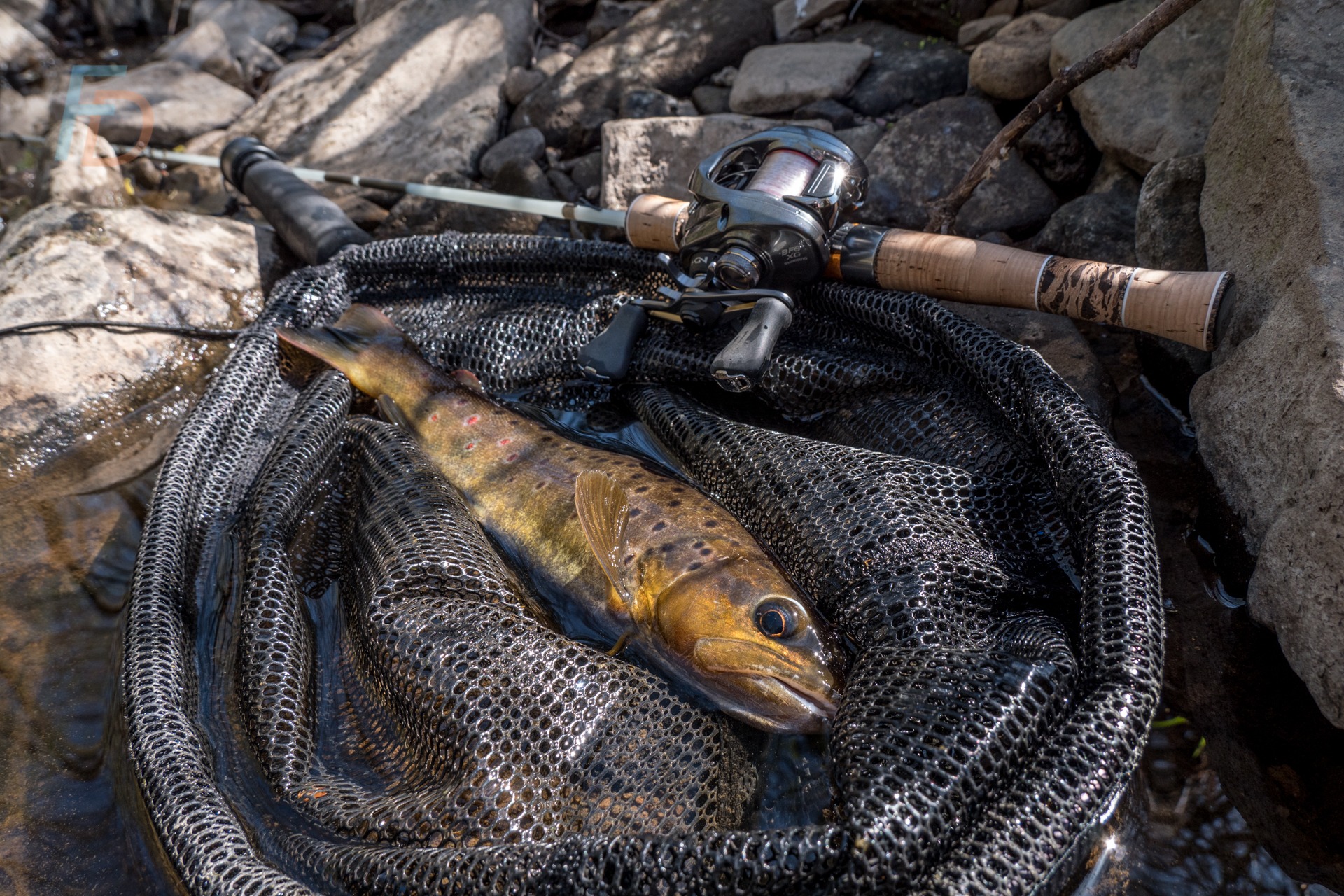
Wild trout caught using an Aldebaran BFS fitted with the Avail Microcast spool (1.5mm deep)
The bottom line is if you have ambitions to cast 1-g (or even lighter!) lures; an ultralight after-market spool is essential for the Aldebaran. That's where you will see a much bigger gap in performance between standard spools and those with ultralight spools (with significantly lower rotational mass).
What Limitations Does the Aldebaran BFS Have?
This reel has been on the market for a good few years now – so it’s interesting to see how it’s holding up against more recent developments. The analogue/non-clicking casting brake adjustment stands out to me.

Aldebaran FTB casting brake adjustment dial
I expect that there will be people on both sides of the debate for this one – since it allows completely seamless adjustments with no “jumps”. On the other hand, it is very handy for quick adjustments on stream to be able to go back and forward one or two clicks if a strong head wind kicks up.
For me, I do have a preference for the clicking brake adjustment for that reason.
Given the relative expense of the factory version of the reel, needing to super-tune it in order to compete with the current ultra-light “out of the box” champion reel (Daiwa Alphas Air TW 20) may give pause for thought.
With all that said, it is cool to acknowledge that the Shimano Aldebaran BFS 2016 broke the mould for ultralight lure baitcasting reels.
Specifications
Shimano Aldebaran BFS 2016: Round Up
Aldebaran BFS 2016
OK, these are my thoughts and personal experiences (along with the dry numbers) with the Aldebaran BFS (2016 model). Let me know in the comments below whether this is useful in your product research - or what you disagree with.
Paul

Great Information Paul! I want to get your opinion on the new Shimano Calcutta BFS 23. I noticed there are two gear ratios now, 7.8 and 8.9. Is there much of a difference to get one vs the other, especially for BFS bass fishing?
So – I’ll start out by saying I’ve not fished the ’23 Conquest BFS in either gear ratio.
However, because spool diameters vary a little bit between different models, the key thing to look at is how many inches (or centimetres) of line are retrieved per handle turn.
That will give you a much truer sense of how fast the line recovery actually is.
Shimano state that:
7.8:1 ratio gives 28 inches per handle turn
8.9:1 ratio gives 31.9 inches per handle turn
At the most basic estimation I’d say you’d benefit from the higher ratio when throwing baits upstream in a fast mountain river – and perhaps for a pitching/flipping style of bass fishing where you are really only expecting hits at the full extent of your cast (and you just want to rip the bait back to you as fast as possible to re-cast if you don’t hook up).
Many people find, depending on the cadence of the crankbait, that a slightly lower gear ratio can help them match the correct speed to swim their bait. For me, it is perhaps a reflection of my personality, but I find it reassuring to have a higher gear ratio for when I need it – Since it is physically easier to make a fast reel go “slow” than it is to take a slower reel and make it wind fast (making your hand go at the speed of a bee’s wings isn’t a great recipe for a relaxing day on the water).
With all that said, the “lower” ratio and line recovery is still pretty high – and the higher ratio is (for a very compact BFS reel) quite exceptionally high. This is what makes me think it is designed for fishing in flowing water – and flowing water that has quite a current speed to it at that!
As for all tackle opinions – personal preference in reels is king and also, well, highly personal!
Good luck with your decisions.
Paul
Thank you Paul for honestly information. Recently I buyed this wonderful model as new for very low price 200 $. Before I has calcutta conquest bfs 17 and for me BFS system not new. I used for calcutta microcast spools too. But reel weight ald 16 very light. I know too, that this reel produced during the period 2016 – 2021.
Thank you Vitalii and I’m so glad you found this article useful!
Paul
[…] Shimano Aldebaran BFS 2016: Breakthrough Bait Finesse System Reel […]